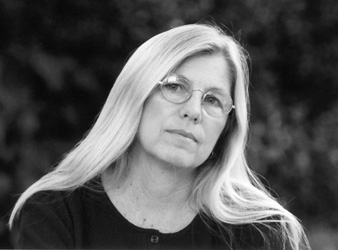 Homefront: A Legacy
Homefront: A Legacy
Arizona war worker writes her Navy boyfriend
a thank-you note for the Jap skull he sent her.
—photo caption, LIFE, 1944
Stationed at her desk, chin resting
pensively in hand, she stares at the skull
almost fondly, almost smiling, as it faces
the camera, hollow-eyed, resting
on its four remaining teeth, lower jaw gone
along with everything else. This soldier has become
a paperweight, a conversation piece
for the blond sweetheart who waits
good-naturedly for her own soldier to return
bringing her picket fence, her station wagon,
her television set. Here's a good Jap...,
the handwriting on the skull
begins, and she says: good.
Earlier she'd used cuticle scissors to snip
the cord crossed over a box delivered
by the U.S. mail; she peeled off brown paper,
lifted the lid and reached in deep
to pull what was left
of this Japanese soldier from his world
into hers. She might be my mother, or yours,
working days at an Army ordnance depot, listening
to radio news and writing love letters
to her overseas boyfriend after work. But LIFE
sent a photographer to catch this
particular moment of tenderness, to document
how unified we are in the effort
of war, the way we stay tightly connected
to each other and our purpose, how the forces
and the homefront resolve to remain
on the same page, and nothing spoils
this picture. She writes: Thank you darling,
for the present, and perhaps
she jokes about the impropriety
of accepting this strange man
into her home where she eats and sleeps
and bathes. She refills her pen,
writes: Hurry home. Hurry
home to my clean, pressed clothes, to the perfume
of my upswept hair, waved and pinned
with crocheted flowers, my perfectly arched eyebrows,
my beautiful long fingers. She doesn't ask:
who killed this man? Doesn't ask:
who boiled and scraped his head
until it was clean and white enough
to write on? who removed it
from his body? She will never ask: what else
have you done? Right now she is content
to believe in goodness. She doesn't think
of the dead Japanese soldier,
doesn't think of his old mother, bracing for her
long night. She doesn't even think
about what she might do
with this strange souvenir when she tires
of rubbing its round, shiny crown.
At some point she'll need
to stow it out of sight, unfashionable relic
of an old religion—slightly embarrassing,
but indisposable. Silent for years
at a time, the thing will settle back
into her hands without warning
on summer nights when she's washing
her husband's thinning hair, him leaning
awkwardly over the sink, her fingers massaging
his soapy scalp, or it will appear to her
on a bright Arizona morning
when she's shown her son's dental x-ray,
as clear and undeniable as god.
For nearly half a century, the skull
will bide its time, tucked away
in the attic, wrapped discreetly
in the daily news like a china teapot,
until someone, maybe
a daughter, pries the lid off
an unlabeled box and recognizes
the efficient blue script
of her dead father's hand
still legible on the bone.








